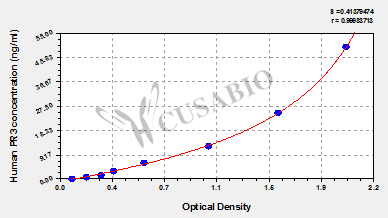CUSABIO's human proteinase 3 (PR3) ELISA kit is an in vitro enzyme-linked immunosorbent assay for the quantitative measurement of human PR3 in serum, tissue homogenates, plasma, or urine. This assay uses the sandwich enzyme immunoassay technique in combination with the enzyme-substrate chromogenic reaction to quantify the analyte in the sample. The color develops positively to the amount of PR3 in samples. The color intensity is measured at 450 nm via a microplate reader.
PR3 (PRTN3) is an enzyme released during neutrophilic inflammation and is capable of cleaving many targets including key structural proteins of the lung. In addition to cleaving structural proteins resulting in tissue remodeling, PR3 also assists in the defensive immune role of the neutrophil including modulating various cellular activities, cleaving host protein into antibacterial peptides, and activating pro-inflammatory cytokines. PR3 also regulates a variety of cytokine functions, which impact processes such as metabolism and inflammasome generation. It also exerts a pro-inflammatory role by interacting with the complement pathway.






